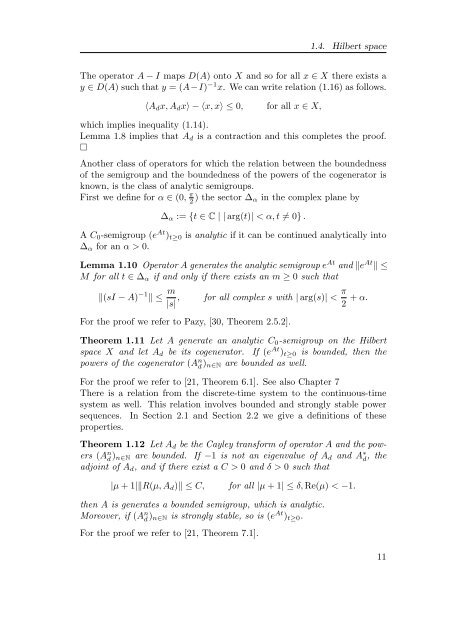PDF - Universiteit Twente
PDF - Universiteit Twente
PDF - Universiteit Twente
You also want an ePaper? Increase the reach of your titles
YUMPU automatically turns print PDFs into web optimized ePapers that Google loves.
1.4. Hilbert space<br />
The operator A − I maps D(A) onto X and so for all x ∈ X there exists a<br />
y ∈ D(A) such that y = (A−I) −1 x. We can write relation (1.16) as follows.<br />
〈Adx, Adx〉 − 〈x, x〉 ≤ 0, for all x ∈ X,<br />
which implies inequality (1.14).<br />
Lemma 1.8 implies that Ad is a contraction and this completes the proof.<br />
�<br />
Another class of operators for which the relation between the boundedness<br />
of the semigroup and the boundedness of the powers of the cogenerator is<br />
known, is the class of analytic semigroups.<br />
First we define for α ∈ (0, π<br />
2 ) the sector ∆α in the complex plane by<br />
∆α := {t ∈ C | | arg(t)| < α, t �= 0} .<br />
A C0-semigroup (e At )t≥0 is analytic if it can be continued analytically into<br />
∆α for an α > 0.<br />
Lemma 1.10 Operator A generates the analytic semigroup e At and �e At � ≤<br />
M for all t ∈ ∆α if and only if there exists an m ≥ 0 such that<br />
�(sI − A) −1 � ≤ m<br />
π<br />
, for all complex s with | arg(s)| < + α.<br />
|s| 2<br />
For the proof we refer to Pazy, [30, Theorem 2.5.2].<br />
Theorem 1.11 Let A generate an analytic C0-semigroup on the Hilbert<br />
space X and let Ad be its cogenerator. If (e At )t≥0 is bounded, then the<br />
powers of the cogenerator (A n d )n∈N are bounded as well.<br />
For the proof we refer to [21, Theorem 6.1]. See also Chapter 7<br />
There is a relation from the discrete-time system to the continuous-time<br />
system as well. This relation involves bounded and strongly stable power<br />
sequences. In Section 2.1 and Section 2.2 we give a definitions of these<br />
properties.<br />
Theorem 1.12 Let Ad be the Cayley transform of operator A and the powers<br />
(An d )n∈N are bounded. If −1 is not an eigenvalue of Ad and A∗ d , the<br />
adjoint of Ad, and if there exist a C > 0 and δ > 0 such that<br />
|µ + 1|�R(µ, Ad)� ≤ C, for all |µ + 1| ≤ δ, Re(µ) < −1.<br />
then A is generates a bounded semigroup, which is analytic.<br />
Moreover, if (A n d )n∈N is strongly stable, so is (e At )t≥0.<br />
For the proof we refer to [21, Theorem 7.1].<br />
11
















